1945
January 25, 1945
The founder and long-time commander of the WTL, SS brigade leader and major general of the Waffen-SS Gustav Diesterweg from January 30, 1944, was transferred to the reserve leadership of the Waffen-SS in the SS leadership headquarters and replaced by SS-Standartenführer Albert Doerheit.
January 00, 1945
After the encirclement of Breslau, the “Functional Unterführerschule der Waffen-SS”, which had only been newly established in 1944, was placed under the command of the combat commander and was included in the fighting with the current 7th course of this type, which was to run until the beginning of March 1945.
The time when the school was re-founded in Dachau is not known.

SS field post from SS-Uscha. E. Woerner, 1./Funkt.Uffz.Schule der Waffen-SS 13 b Dachau 3 with postmark April 3, 1945 (imprint “Forwarding prevented by wartime conditions”)
to the Mayor Woerner family in Mühlacker, Württemberg, Hindenburgstr. 51
Dachau, Easter 1945. “Dear parents! First, my warmest Easter greetings. Unfortunately, this time we can’t celebrate it together like we did last year and unfortunately things look completely different this time. But there is still no reason to despair, everything will be fine.
I really hope that you are still doing well, because I haven’t received any mail from you in a long time, and it won’t be the case any time soon.
Hopefully you have received my last letters and….”
So this school existed in Dachau at the beginning of April 1945! Further information is missing so far (June 13, 2018)
February 19, 1945
57.Cooking course a. d. SS training kitchen Dachau 02/19/45 – 03/16/45
March 24, 1945
Action “Leuthen” in WW VII as part of the “Visigoth movement”:
According to the orders of the deputy Gen.Kdo. VII.AK (Wehrkreis-Kdo VII), No. 4952/45 case, Ib/Mob.1, II. Angel. On March 24, 1945, the formation of the “Bavaria Training Division” was ordered.
The Waffen-SS units in World War VII also mobilized as part of the “Gneisenau” call.
(Joachim Brückner, End of the War in Bavaria, individual writings on the military history of the Second World War 30 MGFA, pp. 40-41)
February 19, 1945
57.Cooking course a. d. SS training kitchen Dachau 02/19/45 – 03/16/45
March 24, 1945
Action “Leuthen” in WW VII as part of the “Visigoth movement”:
According to the orders of the deputy Gen.Kdo. VII.AK (Wehrkreis-Kdo VII), No. 4952/45 case, Ib/Mob.1, II. Angel. On March 24, 1945, the formation of the “Bavaria Training Division” was ordered.
The Waffen-SS units in World War VII also mobilized as part of the “Gneisenau” call.
(Joachim Brückner, End of the War in Bavaria, individual writings on the military history of the Second World War 30 MGFA, pp. 40-41)
March 31, 1945
“…the following scan is part of a letter that belongs to the Vilzmann document collection.
I will be happy to introduce this here soon, it recently came into my collection.

My question today:
This letter is from a blocking bag. Widmann, signature is from Captain Widmann, I can read it.
I think I can see the runes in the header.
Now there was an officer named Hans Widmann, who was a first lieutenant in the III./Gren.Rgt. 61 was awarded the German Cross in Gold on December 15, 1944. Vilzmann was also a member of the Gren.Rgt. 61 and this letter goes to the replacement unit 61. So I assume this Widmann is the first lieutenant from GR 61.
My question to you: What’s with this barrier bag? Widmann on himself. What kind of unit was that?
Since “Dachau” is mentioned as the place, I of course looked through the book “The End of the War in Bavaria” by Joachim Brückner – unfortunately without success, as did a Google search.
Can one of you help me?
Greetings – Armin. …” (Armin Rudzki in
https://www.forum-der-wehrmacht.de/index.php?thread/57048-ss-sperr-btl-widmann/
April 17, 1945
As early as April 4, 1945, the head of the WVHA ordered the division of the main office into two groups, “North” and “South”.
(Andreas Schulz, Dieter Zinke, Generals of the Waffen-SS and Police, Volume 4, Biblio, 2009, p.45)
“… On April 14, 1945, Official Group B was relocated to Munich as Group South. However, as a result of the war, we were no longer able to continue working…”
(Andreas Schulz, Dieter Zinke, Generals of the Waffen-SS and Police, Volume 3, Biblio, 2008, p. 51, note 37 as Georg Lörner’s CV dated November 30, 1945, arrived in Dachau on April 17, Georg Lörner and his older brother Johann “Hans” went on excessive drinking bouts, see also p. 44 Johann “Hans” Lörner, SS-Oberführer der Waffen-SS, among others from December 1st, 1942 – May 8th, 1945, head of the Office A I (budget office) in the WVHA)
On April 15, 1945, at around 5 p.m., the majority of the WVHA employees, including the head of the main office, SS Obergruppenführer and General of the Waffen-SS Oswald Pohl, moved to southern Germany. At their own request, employees were also able to stay in Berlin, where SS Oberführer Salpeter took over the remaining members of the WVHA.
Dachau was reached on April 17, 1945, but only the official groups A and B in southern Germany were still in operation.
The approximately 10 employees still at Staff W also went to Dachau under SS Oberführer Hans Baier.
A reconstruction of the SS administration was no longer possible due to the rapid advance of the Allies. Rather, the approximately 50 to 70 employees of Office Group A under SS Brigade Leader Heinz Fanslau and Office Group B, which was reduced to around 70 employees under SS Group Leader and Lieutenant General of the Waffen-SS Georg Lörner, concentrated on preparations for a further evacuation towards Bayrischzell.
The Amt D group, which initially remained in Oranienburg, under SS group leader and Lieutenant General of the Waffen-SS Richard Glücks, managed to maintain contact with the new headquarters of the WVHA thanks to a direct radio connection to KL Dachau. After Oranienburg was evacuated, this connection was completely broken off.
During the week that followed the retreat to southern Germany, Pohl stayed overnight at his wife’s property near Dachau, the Brüningsau estate, where his SS-Hstuf adjutant also stayed. Werner Schiller (* October 7, 2016, Oldenburg) and his OO, Witt, were alive.
(Jan Erik Schulte, Forced labor and extermination. The economic empire of the SS, Schöningh, 2001, pp. 427 – 428, see also (Andreas Schulz, Dieter Zinke, Generals of the Waffen-SS and Police, Volume 4, Biblio, 2009, p. 45, after which Pohl, Fanslau and Georg Lörner came from Berlin with 400 employees to Dachau, where Pohl stayed with 10 men, while the rest continued to “make their way”)
Pohl is said to have occupied a “command post” in the so-called plantation of KL Dachau from April 17th to 23rd, 1945.
(Andreas Schulz, Dieter Zinke, Generals of the Waffen-SS and Police, Volume 4, Biblio, 2009, p. 45)
April 16, 1945
59.Cooking course a. d. SS training kitchen Dachau April 16, 1945 – May 11, 1945
April 18, 1945
In view of the enemy forces advancing ever further into southern Germany, the personnel and courses at the SS Weapons Technical Training Institute (WTL der SS) Dachau were reorganized into combat companies from April 18, 1945.

20.04.1945
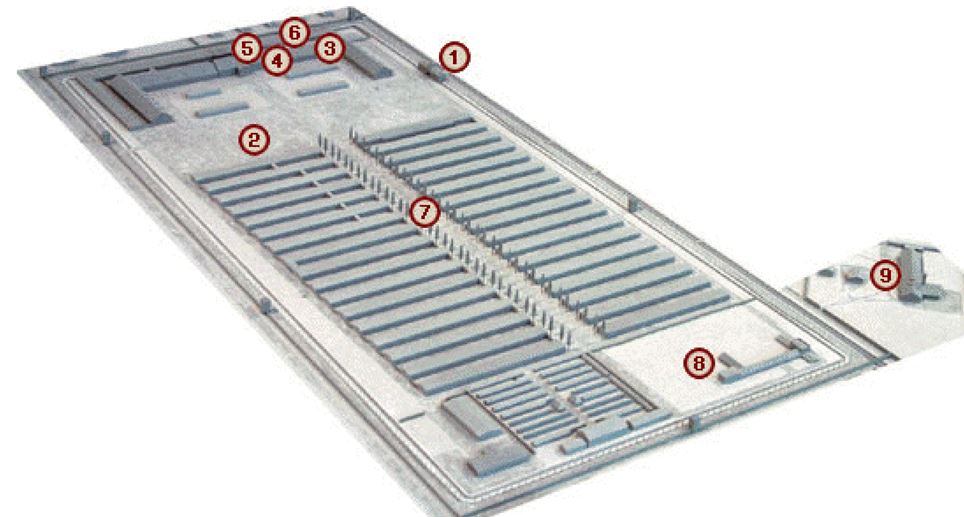
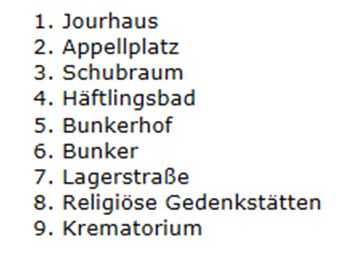
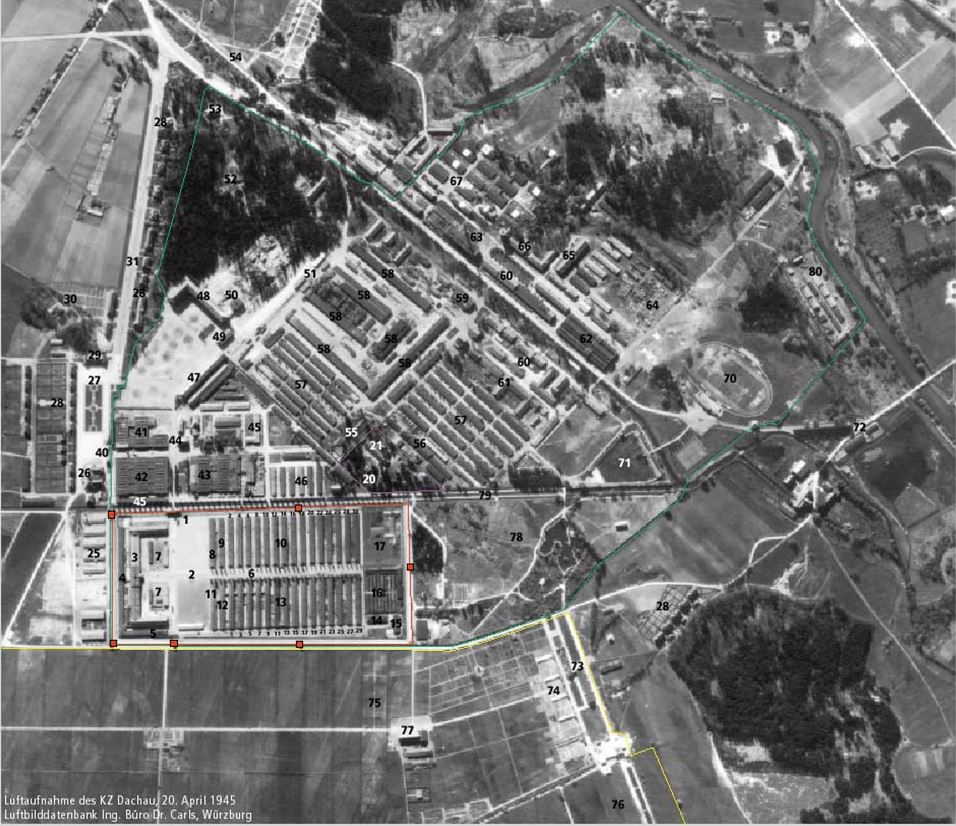
1 Jourhaus mit Lagereingang
2 Appellplatz
3 Wirtschaftsgebäude
4 Bunker
5 Straflager der Waffen-SS und Polizei
6 Lagerstraße
7 Materiallager
8 Lagermuseum, Kantine
9 Arbeitseinsatz, Messerschmitt-Werkstätte
10 Unterkunftsbaracken für Häftlinge (Block 2 – 30)
11 Krankenrevierbaracke A (Ambulanz, Operationssäle)
12 Krankenrevierbaracke B (Schreibstube, SS-Ärzte, Totenkammer)
13 Revier- und Quarantänebaracken (Block 1– 29)
Revierblock 1: Malariaversuche,
Phlegmone-Abteilung
Revierblock 3: Internistische
Abteilung, Malariaversuche
Revierblock 5: TBC-Abteilung,
Höhen- und Unterkühlungsversuche 1942
Revierblock 7: Krankenstuben
Revierblock 9, 11: TBC-Stationen
Revierblock 13 – 29: Quarantäne
14 Block 31: Sonderbaracke (Bordell)
15 Desinfektion
16 Ställe für Angorakaninchen
17 Lagergärtnerei
20 Altes Krematorium
21 Großes Krematorium
25 Werkstätten des Heereszeugamts
26 SS-Gemeinschaftshaus
27 Eickeplatz
28 Wohngebäude für SS-Angehörige
29 Gaststätte, Laden
30 Kommandantenvilla
31 Straße der SS
40 Torhaus / Eingang zum SS-Lager
41 Lagerbäckerei, Lager und Garagen SS-Bekleidungswerke
42 Lager der SS-Bekleidungswerke
43 Werkstätten der Deutschen Ausrüstungs-Werke (DAW)
44 Kommandantur des Konzentrationslagers
45 Politische Abteilung (Gestapo)
46 Baracken-Unterkünfte der KZ-Wachmannschaften
47 Besoldungsstelle der Waffen-SS
48 SS-Kaserne und Verwaltung
49 SS-Standortverwaltung
50 Luftschutzbunker (Hollerith-Bunker)
51 Tankstelle
52 Waldheim, Dienstwohnung SS-Standortkommandant
53 SS-Führerheim (Waldcasino)
54 Standort des Todeszuges bei der Befreiung
55 Hundezwinger
56 Zentralbauleitung der Waffen-SS und Polizei (Baulager)
57 Baracken-Unterkünfte für SS-Mannschaften
58 Garagen
59 (SS-) Porzellanmanufaktur Allach
60 Waffentechnische Lehranstalt der SS
61 SS-Bekleidungswerk/Schneiderei
62 „Holländer“-Halle (Lager und Werkstätten)
63 Fernheizwerk
64 Materiallager
65 SS-Führerschule des Verwaltungsdienstes
66 Reichsführer SS, Abt. „F“ (Dr. Fahrenkamp)
67 SS-Lazarett
70 SS-Sportplatz
71 SS-Schwimmbad
72 Entomologisches Institut
73 Plantage (Kräutergarten) Wirtschaftsgebäude
74 Gewächshäuser
75 Bereich „Freiland I“ der Plantage
76 Bereich „Freiland II“ der Plantage
77 Darregebäude
78 Wildpark
79 Würmkanal
80 Präzifix Werkstätten
April 23, 1945
On April 23, 1945, the head of the WVHA, SS Obergruppenführer and General of the Waffen-SS Oswald Pohl, left his “command post” in Dachau to seek safety from the advancing Allies.
(Jan Erik Schulte, Forced Labor and Extermination. The Economic Empire of the SS, Schöningh, 2001, p. 430)
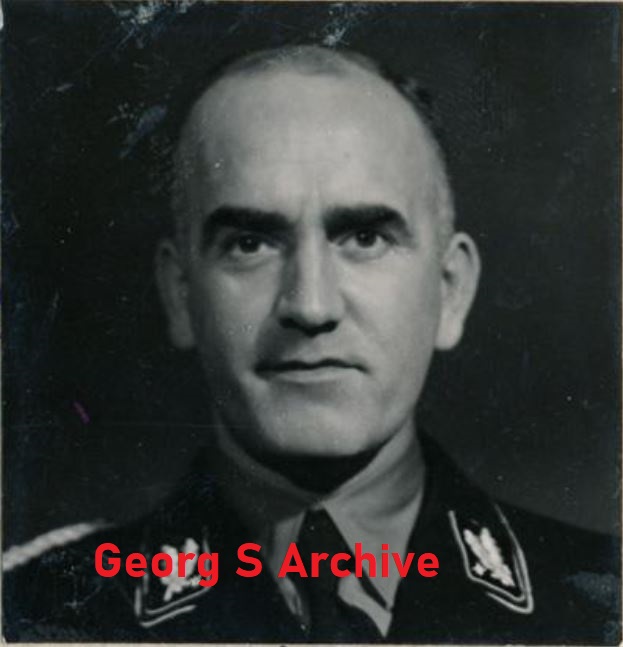
It is not known when the head of Office Group B of the WVHA, SS group leader and Lieutenant General of the Waffen-SS Georg Lörner, left Dachau.
He escaped with members of his staff into the mountains via Schliersee, Bayrischzell and Thiersee, Tyrol.
(Andreas Schulz, Dieter Zinke, Generals of the Waffen-SS and Police, Volume 3, Biblio, 2008, p.
51)
April 26, 1945
When the American troops approached the Munich area on April 26, 1945, additional combat units were put together from the troops stationed in the greater Munich area and the personnel of the offices and other facilities of the Waffen-SS and formed an SS unit with the combat companies of the WTL of the SS. Alarm Regiment “Dachau”, also known as SS Regiment Freimann, summarized.
As far as can be determined, the shutdowns were made by:
- the SS-Totenkopf-Wachsturmbann Dachau
- the Training and Replacement Abbot of the SS Administrative Services Dachau
- the salary office of the Waffen-SS Dachau
- the SS Weapons Technical Training Institute with 1st Inspection, SS-Ostuf. Karl Wolf
2nd inspection, SS-Ostuf Oskar Röntgen - the SS training kitchen in Dachau
- the SS clothing factory in Dachau
- the vocational school of the Waffen-SS Schleißheim (meaning: discharge point of the Waffen-SS
Schleißheim, the vocational school had already been moved to Mittweida, the author.) - Parts of the SS-Flak-AuE-Rgt Munich
- SS Guard Company 7 Munich
- Members of the Waffen-SS from the hospitals in Upper Bavaria
- Dispersed members of the Waffen-SS
- a remnant group from SS-GebJgAuE-Btl 6 Hallein under SS-OJ Hoy
The SS Volkssturm Battalion Augsburg (?, the author, but so WV) was also added, and a unit of SS pupils is also said to have been added to the regiment.
As the American troops approached Munich on their advance from the area north of Augsburg, the discharge center of the Waffen-SS Schleißheim was closed on April 28, 1945.
Parts of the permanent staff as well as members of the “transit company” volunteered for the SS Alarm Regiment Dachau. (see also manuscript WV discharge office of the Waffen-SS)
The commander was the previous commander of the SS Weapons Technical Training Institute, SS-Standartenführer Albert Doerheit.
The staff consisted almost exclusively of Bavarians or Ostmarkers.
According to unconfirmed information, the regiment was divided into two battalions. Individual units assigned to the regiment sometimes operated independently.
Deployed until April 29, 1945 to secure the greater Munich area, including the Isar bridges in Munich itself.
(WV, see also Brückner, End of the War in Bavaria, pp. 199-200, 202, 205, Stöber, XIII.SS-AK, pp. 342, 344)
Operational strength of the units subordinate to the Central Protected Area according to the last available report from the Munich Military District Command, Lieutenant Colonel Hofmann, to the deputy. Gen. Kdo VII of April 26, 1945, Az So., File 13 g – K./Ia: Accordingly, the Wehrmacht (since April 23, 1945 “combat”) commander only commanded one company of the army from the grenadier replacement and Training Battalion 19 with a strength of 4 officers, 23 non-commissioned officers and 144 men. The interpreter company in World War VII was not intended for combat use.
SS units in Freimarn, SS-Flak-AuE-Rgt, and Dachau, WTL of the Waffen-SS, were ready for enemy attacks against the northern outskirts of Munich; their combat strength was less than 1,000 men each.
The Volkssturm and the police could not be deployed as a unit. The seven companies of the Pioneer Replacement and Training Battalion 7 could not be counted on either, as they were divided into blocking squads and were not available as closed units.
(Joachim Brückner, End of the War in Bavaria, individual writings on the military history of the Second World War 30 MGFA, p. 182, BA-MA RW 17/48)
April 27, 1945
Munich was now threatened from the west and north, and Field Marshal Kesselring, as Mayor West, therefore feared that the enemy attacking from the west would push into the rear of the 1st Army via Munich. He therefore ordered a rear barrier to be prepared along the Isar, Amper and Glonn and from Ammersee to Schongau.
Major General Freiherr von Buddenbrock of the XIII.AK (Army) was tasked with exploring and preparing barriers in the Ammersee area and south of it. On April 26, 1945, company-sized units from the Munich area had already been relocated to the Glonn section near Odelzhausen – Sulzemoos and near Petershausen, Markt Indersdorf.
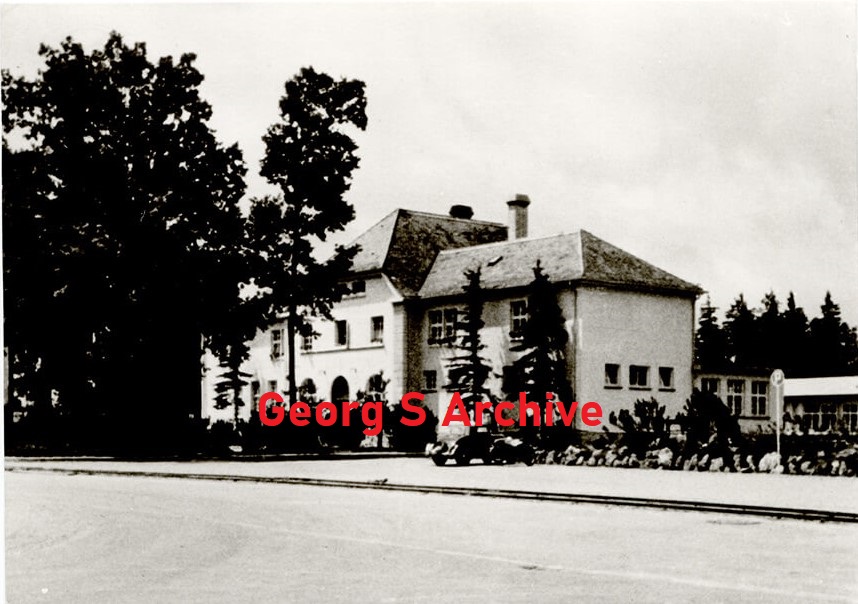
These were in each case the companies of the Weapons Technical Training Institute of the Waffen-SS, which belonged to the “Mitte Protected Area”. (Daily report from the Mitte protected area to the Deputy Gen.Kdo VII.AK from April 26th and 27th, 1945, BA-MA RW 17/46)
Explorations for such an operation had been taking place for a long time, because the greater Munich area with its Isar crossings north and south of the city could only be defended here, if at all.
(Joachim Brückner, End of the War in Bavaria, individual writings on the military history of the Second World War 30 MGFA, p. 181)
A first deployment of parts of the SS-Alarm-Rgt. Dachau, including a combat company of the WTL of the SS, took place on April 27th/28th, 1945 when suppressing a prisoner uprising in KL Dachau. (WV)
April 28, 1945
Deployment of parts of the Dachau Regiment, including SS-Wachkompanie 7 and combat groups of the SS-Flak-AuE-Rgt, against the “Bavarian Freedom Action”
April 29, 1945
On the night of April 29, 1945, the units of the KGr. von Hobe and the 2nd Geb Div moved behind the Amper and Glonn sections and again took up a front, the KGr. from Hobe on the Glonn section between Arnbach and the Augsburg-Munich motorway, on both sides of Freising behind the Amper section were the 352.VGD and the 2.GebDiv.
The 2nd GebDiv had to go on April 29th. Give up Freising and retreat behind the Isar. Into the front gap to the KGr. From Hobe, the 20th US PD pushed along State Road 13 to Schleissheim Airfield. Further west, the 42nd and 45th US ID reached KL Dachau around 1:00 p.m.
The camp was evacuated on April 26, 1945 by 7,000 prisoners, who over the next few days were driven in a miserable procession via Gauting, Percha to Waakirchen near Tölz. In the camp itself there were indescribable conditions. It was completely overcrowded with 30,000 prisoners who had been transferred here from other camps in recent weeks. Diseases had spread. Because of the international importance of this camp, the American armed forces had commissioned the Deputy Div.Kdr of the 42nd US ID, Brigadier General Linden, to take over the camp.
The handover was carried out by the head of the International Prisoners’ Committee, the Belgian Albert Guerisse, and on the German military side by a young first lieutenant who had recently been transferred to the Waffen-SS and had been in charge of camp management for a few days.
The American soldiers’ shock at the conditions in the camp was expressed in a massacre immediately after the handover: all SS guards were shot, including the first lieutenant who had just handed over the camp.
An eyewitness stated that the long-standing security personnel were constantly being replaced. After the partial evacuation in the final phase of the camp, young recruits from the Waffen-SS were then deployed to guard it. They atone for the guilt of others. In this context, the After Action Report of the 7th US Army speaks of 300 SS men shot.
The advance of the 42nd US ID to Dachau also tore the KGr apart. from Hobe, which tried to fight back on both sides of the Aichach – Dachau road. An SS regiment deployed north of Dachau was assigned to the KGr. Although now assumed, Hobe’s staff could no longer influence its management due to the interim capture of KL Dachau. The SS regiment was taken back to Freimann.
(Joachim Brückner, End of the War in Bavaria, individual writings on the military history of the Second World War 30 MGFA, pp. 192, 196, 198 – 200)
The SS Alarm Rgt. On April 29, 1945 (?), Dachau took up a defensive position north of Munich on the Glonn, including parts of the SS WTL, and on both sides of the Reichsautobahn Augsburg – Munich on the Lauterbach – Markt Indersdorf line. The command post was initially located in the SS troop camp at Dachau. (WV)
The SS regiment in KL Dachau was supposed to close a gap of 10 km to the right of the 212.VGD, south of Munich.
Instead, the Rgt. was deployed north of Munich, hard north of Dachau, and the KGr. assumed by Hobe. Rgts staff in KL Dachau was already deployed north of the Amper. The regiment, which then fought its way back to Freimann, prevented the Americans from advancing quickly toward Munich.
An SS battalion set up at short notice in Augsburg under SS-Hauptsturmführer Freiherr von Truchsess, which was to be added to the regiment, took up field positions near Webling and was engaged in defensive combat around midday on April 29, 1945. SS-Hstuf. von Truchsess and parts of his battalion were taken prisoner by the Americans in Webling and were subsequently killed along with 43 other members of the Waffen-SS.
(Günther, 17.SS, Vol. III, p. 405 – 406 SS-Hstuf. Heinrich Frhr.v. Truchseß, * 6. 4.02, SS-No. 14 962, 5.41 Ostuf. i. Kav.Rgt.2, 6.44 Hstuf. u. z.b.V., SS-Flak-Abt.9, † 29. 4.45)
The 212.VGD had left the Dachau area without orders from the XIII. SS A.K. Withdrew to Forstenrieder Park and came into the command area of the XIII. A.K. (Army).
The then O1 of the division Gottfried Pfeiffer reported on the background:
“… In the Dachau area we found ourselves in a “situation” that I would like to describe in particular detail because the behavior of my division was obviously not understood.
Our division stood north of Dachau without an enemy in front of the front in the north. Explorations to the left and right led to enemy contact.
Major Reinwald had a confrontation with an SS leader who was citing an order from Himmler that there should be no fighting in the Dachau area.
another tried to take our transport kit. (Capt. Kälble) to assume
others again the reconnaissance train.
At a train station north of Dachau we met the first Air Force members with “discharge papers” (!).
This was the situation when, dead tired, I arrived at the Div. Staff, where Gen. Ulich was desperately trying to establish contact with the XIII. SS A.K. to obtain…
After assessing the situation for several hours, Gen. Ulich made the decision to lead the division into Forstenrieder Park because, according to the unanimous opinion of all officers present, especially the Div.-Adj. Geyer, there was no longer any defense at Dachau. The division was urgently moved west of Munich.
The dramatic hours north of Dachau were more than turbulent… The unanimous verdict: This should be reported to the SS officer. released from the Dachau camp…
I think I can say from memory that the division “in the park” didn’t wait 24 hours for a new mission. All the more disappointing is the sudden news that Gen. Ulich will have to answer to a court-martial…”
(Erich Spiwoks, Hans Stöber, final battle between the Moselle and Inn, Munin, 1976, pp. 333 – 334, see also Keilig, General of the Army, p. 351 Max Ulich, born March 25, 1896, RK and DKiG, 1.12.44 Gen .Maj,, 1.4.44 – 31.3.45 Chief Gen.St. Deputy VII. A.K., 1.4.45 212.I.D., survived the war, then lived in Munich)

On April 29, 1945, the SS hospital in Dachau was handed over by the head doctor, SS-Sturmbannführer Dr. med. Schröder (possibly also Schroeter?), to the American troops who occupied Dachau.
After the proper handover, numerous seriously wounded people and members of the hospital staff were shot indiscriminately by the American soldiers.
(BA-MA N 756 Wolfgang Vopersal, SS-Lazarett Dachau, undated, 2 pages, here p.1 and 2 above)
Schroeter, Erwin Dr. Hstuf. 26. 6.07 401 306 SS hospital Dachau 11.44
Hstuf. Danzig SS-FHA 5.44
Unfortunately, there is no map in the chronicle of the 42nd US Division that shows the division’s route to Dachau or Munich.
It is mentioned in the chronicle that at 05:00 on April 29, regimental combat groups were formed to accelerate the division’s advance, and at 06:35 the motorized II./US-IR 222 followed behind the tanks (the 20th US- Pz.Div., the author) towards Munich, the I./222 followed the II. Btl. while the III. Btl. combed the regimental section and dug out isolated pockets of resistance.
It was similar with the US-IR 242, the III. Btl. was motorized, the I. Btl. followed the III. and the II. Btl. took care of the Rgts. section.
The US-IR 232 followed the CCA of the 20th US Pz.Div. and then entered the reserve of the XV in a meeting room. Corps.
At 1 p.m. the II./US-IR 222 reached Dachau, but only a small group of officers from the US-IR 222 and men under Brigadier-General Linden went to the camp.
According to the chronicle, the Dachau camp was handed over by a representative of the Swiss Red Cross. “A young German (first) lieutenant (in the original just “Luitennant”), who had been brought to this camp from the Eastern Front just two days earlier, “surrendered it” to the general.”
Then the II Btl. advanced and wiped out the SS guards, who refused to surrender and opened sniper fire on the advancing Americans.
After clearing the camp, the II./US-IR 222 continued its advance to the Amper and towards Munich.
The US-IR242, which traveled over the highway, also reached the Amper by the evening of April 29, 1945.
Management of KL Dachau, among others
SS Obersturmbannführer Martin Weiss
SS-Obersturmbannführer Eduard Weiter – April 26, 1945
(Rolf Michaelis, The Waffen-SS. Myth and Reality. Documentation about the personnel composition and deployment of the Waffen-SS, Berlin, 2006, p. 328)
Letter from the head of the security police and the SD – IV – g.Rs., v. April 5, 1945 to the commander of KL Dachau, SS-Obersturmbannführer Next – Personal
(Topography of Horror Foundation, Berlin, 2010. P. 110 from PS Best, The Venlo Incident, 1951)
SS Ostubaf. Martin Weiß, “Amtschef z.b.V.” in Office Group D of the SS-WVHA since May 18, 1944, was in Dachau again at the end of April 1945, possibly to relieve the camp commandant Eduard Weiter and to eliminate grievances.
On April 28, 1945, he discussed the handover of the camp to the US Army with SS-Standartenführer Kurt Becher.
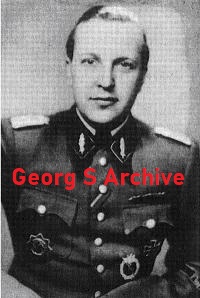
On April 28th or 29th, 1945, Weiß left Dachau. On May 2, 1945 he was captured by American troops in Mühldorf am Inn.
https://de.wikipedia.org/wiki/Martin_Gottfried_Wei%C3%9F
The SS-Standartenführer (since January 1, 1945) Kurt Becher was appointed “Reich Special Commissioner for all concentration camps” on April 9, 1945.
It is not known how long he stayed in Dachau; he was arrested by American military authorities in Nuremberg in May 1945.
He is said to have been in Bergen-Belsen on April 10, 1945, until he arrived in Mauthausen on May 5, 1945. Becher and some of his staff hid in Weißenbach (north of Altausee?) until he was arrested by the Americans on May 12, 1945.
(Karla Müller-Tupath, Reichsführer’s most obedient cup. A German career, Konkret Literatur Verlag, 1982, pp. 121 – 122, in Weißenbach were:
Kurt Becher, born September 12, 1909 Hamburg,
SS-Ostuf. Karl Grabau, born October 10, 1911 Hamburg
SS-Ostuf. Josef Weber, born September 25, 1911 Bodenbach/Elbe and their driver
Kurt Helfer, born November 1, 1919 Rielasingen/Baden
SS Oscha. Emil Wolff, born September 18, 1909 Sternbeck/Krs. Oberbarnim, “Reservists of the Waffen-SS”)
Grabau, Karl, born on October 10, 1911, in Harburg, head of the SS site administration in Radom June 42-June 43, SS Obersturmführer. SS no. 228 822?
Camp management: Martin Weiß from April 26 to April 28, 1945, Johannes Otto on April 28, 1945, and Heinrich Wicker on April 28 and 29, 1945. The handover to the American troops was carried out by the 23-year-old SS-Untersturmführer Heinrich Wicker
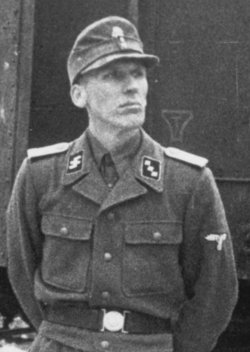
Otto, Johannes Ostuf. 12/24/06 292 442 SS-WVHA Amtgr. D 8.43
Ustuf. Oederan SS-WVHA Amtgr. D 1.42
The former prisoner Edgar Kupfer-Koberwitz also remembered April 29, 1945 in his Dachau diaries: “… Suddenly the news: There are white flags on the towers! Everyone is delighted, which can only mean that the camp has surrendered. I don’t believe it myself, I think it’s just to make the boundaries of the camp clear, and there’s still the SS on the towers, there are supposed to be 200 SS men still in the camp.
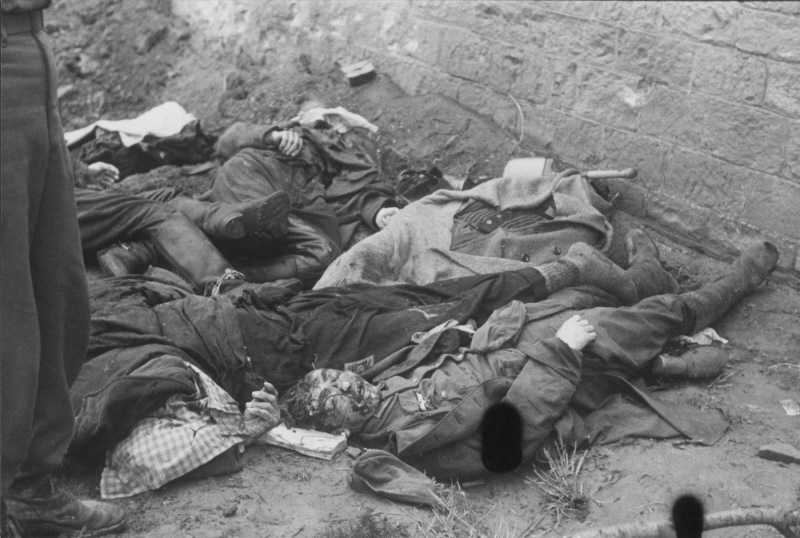
Suddenly outside there is shouting, running, running: The Americans are in the camp, yes, yes, they are at the roll call area! Everything starts moving, the sick leave their beds, the almost healthy and the staff run onto the block…
Comrades come, come back, talk breathlessly: The Americans on the roll call square! They shoot down all the SS. The camp is taken, we are free, free!
The Americans ordered the guards to climb down from the towers and come out of the bunkers… Everyone was shot, the Americans didn’t leave any of the SS men who fell into their hands alive. A comrade who saw this then told me what he felt, because it horrified him to see how people were shot down despite their hands raised, falling, bleeding and dying moaning…
The dead SS men are now lying everywhere in the camp area…. Some… take away the wristwatches, cameras and even the boots from the dead SS…
I’ve just heard that agitated prisoners snatched the submachine guns out of the hands of the US soldiers and shot the SS men, their hands raised to me as they stood behind the electric wire fence. Many comrades were outraged about this…
It was a beautiful and yet such a bloody Sunday. Strange how everything comes full circle the way it began. It all started bloodily and ended bloodily
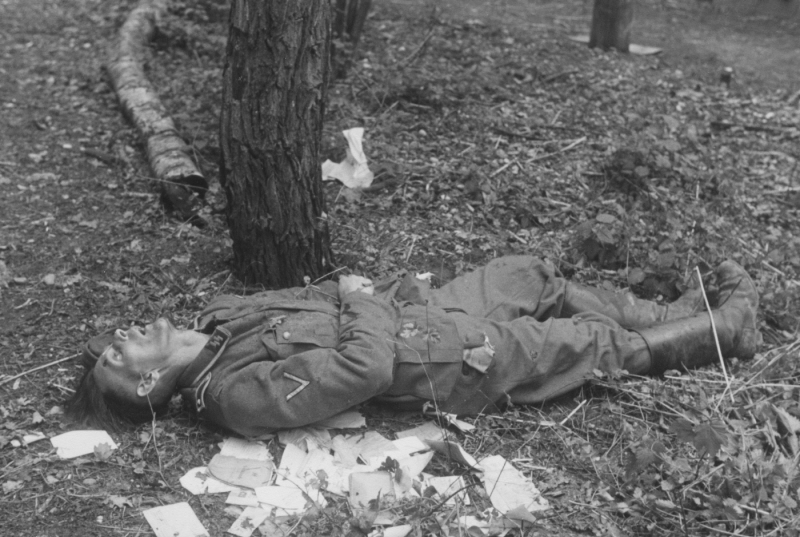
After the capitulation, Jost W. Schneider came from the Rottach-Egern camp via Berchtesgaden and the Oberpfaffenhofen airfield work detail to the Dachau camp and Bunker I around August or September 1945. In this context, he remembered that “… as a German doctor Stubaf./Ostubaf. Dr. Fierlings,
Fierlings, Paul Dr Stubaf. 18. 3.05 308 833 IVb,Pz.GR.95 4.45
Stubaf. Düsseldorf IVb,II./Art.Rgt.6 4.44
At that time he was, in my opinion, a bad assistant to the Americans…”.
“… out of the bunker, in the hospital, i.e. H. Around spring/summer 1946, I saw the “defense line” north of the camp complex, built-in Panzer III and IV cupolas at various work detachments, all of which were installed in the direction of Amper and Moor. These things were no longer fired, as several prisoners assured me.
In the warehouse itself from April 28th. Numerous prisoners armed themselves with the weapons they had from Staf. Dryness
Doerheit, Albert Staf. 20. 9.94 44 483 SS-WTL 1.45
Ostubaf. Blocks Kdr. Landstorm Nederland 4.44
Ostubaf. Kdr.Nachsch.9 2.44
Stubaf. Kdr.T.I.R.15 6.40
W.T.L. (Weapons Technical Training Institute, the author) had to repair them and tore them out from under the wooden floors of the barracks. Since the permanent staff had been piled up and moved with transports, the camp towers were mostly occupied by disabled people from the location area. These guards were attacked when the Americans approached and mostly killed; only a small number survived through the intervention of sensible prisoners.
Around 15 – 25 Waffen-SS (members) of all ranks were also murdered at the district heating plant in the on-site storage area, some of them animalistic (1 picture in my archive, not available, the author.)
The conditions up to 1947 and beyond were described to me by the camp priest Leo Roth, a Dominican priest who was (allegedly) imprisoned because of Section 175, who remained in the camp area after the liberation and took over pastoral care for the Waffen-SS. He knew a lot and gradually it became a pleasure to discuss with him. He, whose work had not yet been sufficiently appreciated, made himself unpopular with his superiors through his support of the Waffen-SS, even though Auxiliary Bishop Neuhäusler himself consecrated the chapel in the KL area on Christmas 45 (or 46?). Roth gave such a clear speech against collective guilt at the CIE-Langwasser that he had to go into claustry somewhere in South Tyrol for months. …Roth helped bring the truth to light despite the Dachau KL Museum: that PoWs had to build the “oven” in the crematorium long after the camp had been liberated (at which pot-bellied French ex-prisoners celebrated their “les rescapees de Dachau”) with bronze … (unles.)) – as well as the fact that the shower bath was just a bath and never a gas chamber.
In the 1960s he was “caught” again; one day his body was found on a relatively harmless rock face in the Dolomites. His end, like many things in his troubled life, remained mysterious. …”
(Jost W. Schneider, regarding question 309 a the JS Tölz in June 1945 – DF 1/1975, another memory of the Junker school, January 1975, BA-MA N 756, 2 pages, pp. 1 – 2 middle to Wolfgang Vopersal dated January 26, 1975)
https://de.wikipedia.org/wiki/Leonhard_Roth_(cleric)
With that we close the story about the SS-Standort Dachau. I hope you all have found it interessting. The SS-Standort Dachau is so big all of those departments and units can be devided in more detailed stories. One of them that I will publish a story about is the last Officer of KL Dachau – SS-Ustuf Heinrich Wicker. But more about that later. Thank you Roland for a very interesting story.
Georg Schwab
Author Roland Pfeiffer, some images Georg Schwab


